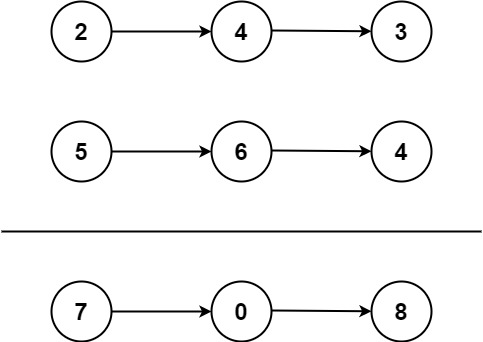题目
You are given two non-empty linked lists representing two non-negative integers. The digits are stored in reverse order, and each of their nodes contains a single digit. Add the two numbers and return the sum as a linked list.
You may assume the two numbers do not contain any leading zero, except the number 0 itself.
Example 1:
Input: l1 = [2,4,3], l2 = [5,6,4]
Output: [7,0,8]
Explanation: 342 + 465 = 807.
Example 2:
Input: l1 = [0], l2 = [0]
Output: [0]
Example 3:
Input: l1 = [9,9,9,9,9,9,9], l2 = [9,9,9,9]
Output: [8,9,9,9,0,0,0,1]
Constraints:
The number of nodes in each linked list is in the range [1, 100].
0 <= Node.val <= 9
It is guaranteed that the list represents a number that does not have leading zeros.
解法:模拟
模拟加法,用一个数表示进位,同时从个位开始加,具体看代码,注意写法上的细节
时间复杂度O(n),空间复杂度O(n)
/*** Definition for singly-linked list.* struct ListNode {* int val;* ListNode *next;* ListNode() : val(0), next(nullptr) {}* ListNode(int x) : val(x), next(nullptr) {}* ListNode(int x, ListNode *next) : val(x), next(next) {}* };*/class Solution {public:ListNode* addTwoNumbers(ListNode* l1, ListNode* l2) {auto dummy = new ListNode(-1);auto h = dummy, h1 = l1, h2 = l2;int carry = 0;while (h1 || h2 || carry) {if (h1) {carry += h1->val;h1 = h1->next;}if (h2) {carry += h2->val;h2 = h2->next;}h = h->next = new ListNode(carry % 10);carry /= 10;}return dummy->next;}};

